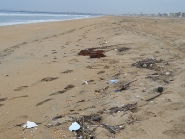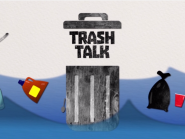What is the Great Pacific Garbage Patch?
Movement
How does marine debris move and where does it go? Wind, gyres, and ocean currents all impact how marine debris gets around.
Floatable marine debris items, once they enter the ocean, are carried via oceanic currents and atmospheric winds. Factors that impact currents and winds, such as El Niño and seasons, also affect the movement of marine debris in the ocean. Debris items can be carried far from their origin, which makes it difficult to determine exactly where an item came from. Oceanic features can also help trap items in debris accumulation zones, often referred to in the media and marine debris community as “garbage patches.”
What is a gyre, and how does debris accumulate in the ocean?
see also:
Resources: Downloads
FAQs
The answer to this is not as simple as you may think. It is certainly not cost-effective to skim the surface of the entire ocean. Even a cleanup focusing on “garbage patches” would be a tremendous challenge. Keep in mind these points:
- Concentration areas move and change throughout the year
- These areas are typically very large (see below)
- The marine debris is not distributed evenly within these areas
- Modes of transport and cleanup will likely require fuel of some sort
- Most of the marine debris found in these areas is small bits of plastic
This all adds up to a bigger challenge than even sifting beach sand to remove bits of marine debris. In some areas where marine debris concentrates, so does marine life. This makes simple skimming of the debris risky—more harm than good may be caused. Remember that much of our ocean life is in the microscopic size range. For example, straining ocean waters for plastics (e.g., microplastics) would capture the plankton that are the base of the marine food web and responsible for 50 percent of the photosynthesis on Earth… roughly equivalent to all land plants!
Also, keep in mind that our oceans are immense areas! The Pacific Ocean is the largest ocean on the planet covering nearly 30 percent of Earth’s surface area (~96 million square miles, or ~15 times the size of the continental US). Surveying less than 1 percent of the North Pacific Ocean, a 3-degree swath between 30° and 35°N and 150° to 180°W, requires covering approximately 1 x 106 km2. If you traveled at 11 knots (20 km/hour), and surveyed during daylight hours (approximately 10 hours a day) the area within 100m off of each side of your ship (Mio et al., 1990), it would take 68 ships one year to cover that area! Now, add to that the fact that these areas of debris concentration have no distinct boundaries, move throughout the year, and are affected by seasons, climate, El Nino, etc.
Much like in the Pacific, there is a North Atlantic Subtropical Gyre made up of four major currents – North Equatorial, Gulf Stream, North Atlantic, and Canary Current. There is also a North Atlantic Subtropical Convergence Zone (STCZ). Its Pacific-sister is a known area of marine debris concentration and is in fact one of the mechanisms of debris deposition in the Hawaiian Islands. Similarly, there are areas of oceanic convergence and eddies (areas that in the Pacific concentrate debris – e.g., western garbage patch) in the Atlantic.
Some research has been conducted and published on marine debris in the Atlantic, mainly on ingestion in Atlantic species of sea turtles and seabirds or on nearshore trawls for plastic particles. There are also been anecdotal reports and some studies of debris concentrations, most notably, Sea Education Association's work in the western North Atlantic and Caribbean Sea (Law et al., 2010). Still, compared to the North Pacific Ocean, there is a paucity of published literature on marine debris in the high-seas Atlantic Ocean.
The term "Pacific Garbage Patch" is a popular nickname for an area of marine debris concentration in the North Pacific Ocean, located in between Hawaii and California. While higher concentrations of litter items can be found in this area, along with other debris such as derelict fishing nets, much of the debris is small pieces of floating plastic that are not immediately evident to the naked eye.



